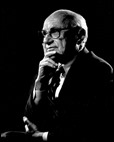John Steele Gordon and Milton Friedman on Inflation
Posted By RichC on March 23, 2022
From a John Steele Gordon lecture at Hillsdale College … “money is just another commodity, no different from petroleum, pork bellies, or pig iron. So money, like all commodities,  can rise and fall in price, depending on supply and demand. But because money is, by definition, the one commodity that is universally accepted in exchange for every other commodity, we have a special term for a fall in the price of money: we call it inflation. As the
can rise and fall in price, depending on supply and demand. But because money is, by definition, the one commodity that is universally accepted in exchange for every other commodity, we have a special term for a fall in the price of money: we call it inflation. As the  price of money falls, the price of every other commodity must go up.” (see link)
price of money falls, the price of every other commodity must go up.” (see link)
“Inflation is always and everywhere a monetary phenomenon in the sense that it is and can be produced only by a more rapid increase in the quantity of money than in output.”
– Milton Friedman, Nobel Prize-winning economist
The history lesson of inflation was most interesting as we all too often recognize it based on our limited personal history. For me, that would be starting in the 1960s after the the death of President John F. Kennedy when Vice President Johnson assumed office.
He pushed through a number of programs, including Medicare and Medicaid, Head Start, and the Mass Transit Act. These new programs caused a breathtaking rise in non-defense federal expenditures. Between 1965 and 1968, they rose by a third, from $75 billion to $100 billion. Because of the Vietnam War, military expenses went up as well, from $50 billion to $82 billion.
This new spending inevitably caused an increase in inflation, which had been minimal since the immediate post-war years. A vicious cycle developed, with lenders demanding higher interest rates to protect them from inflation, while the Federal Reserve pumped up the money supply by buying federal bonds to keep interest rates down.
..
By 1980, the inflation rate hit 13.5 percent, the highest peacetime rate in history. Although the national debt increased by two-and-a-half times in the 1970s, so great was the inflation in that decade that the debt actually declined as a percentage of GDP.
Only when Paul Volcker became chairman of the Federal Reserve in 1979, and Ronald Reagan became president in 1981, did inflation end. The Federal Reserve sharply increased interest rates, pushing the economy into a deep recession. Unemployment hit 10.8 percent at its peak, the highest since the 1930s. But it worked. Inflation, which had been 13.5 percent in 1980, was down to 4.1 percent in 1984 and would stay low for the next few decades.
The current look at inflation we may have studied often … but the deeper history when talking about rises and falls of great societies is also interesting.
.. inflation wracked the Roman Empire as emperors, unable to pay the bills, increasingly debased the coinage. The once proud silver denarius became a copper coin only thinly plated in silver. Roman merchants demanded more and more denarii in exchange for goods as the coin’s intrinsic value declined.
..
In the sixteenth century, as the gold and silver pouring into Spain from the New World caused a rapid rise in the European money supply relative to the production of goods and services, prices rose about 400 percent over the course of the century.
..
War is, by far, the most expensive of all government operations. And both the Confederate and United States governments faced unprecedented financial stresses in funding the Civil War.
..
The Federal Reserve had pushed up interest rates in 1928 and 1929 in order to tamp down speculation on Wall Street. But after the crash of 1929, the Federal Reserve should have lowered them aggressively ..
..
With the onset of World War II .. inflation would have quickly returned as the American economy experienced shortages in many vital commodities. But strict wage and price controls were put in place and many commodities, such as sugar, butter, red meat, shoes, and gasoline, were severely rationed. .. but while the wage and price controls kept wartime inflation down to about 25%, they did not eliminate the inflationary pressures—they only postponed them.
Most of us uncomfortably remember the “Great Recession” in 2007 – 2009 and should have recognized the housing bubble in the years prior. Those in a position to do something (just as during the late 1990’s DOTcom bubble) did very little to slow or tamp down the speculation and banking craziness.
That brings us to the excessive money printing and deficits we see today. Up until now, the past decades rapid increase in money supply did not immediately set off inflation … in fact it has remain surprisingly low. But as John Steele Gordon comments in his article (see PDF):
.. with the Biden administration continuing pandemic relief, which discouraged many from seeking work, and restricting oil and gas production, inflation set in. Supply chain disruptions also contributed.
By December 2021, consumer prices were up 7% on an annual basis, the highest in 40 years, while producer prices were up 9.6%, the highest since that statistic has been compiled. And the expectation of further inflation is now deeply embedded in the economy.
Regardless of this, the Biden administration is still pushing hard for its “Build Back Better” plan, which would add at least another $5 trillion to the national debt over the next decade. And President Biden has airily said that “Milton Friedman is no longer in charge.”
But unfortunately for the Biden presidency—and for the U.S. economy and the American people—Milton Friedman was right. Create too much money and you get inflation. We are witnessing the proof of that right now.
Comments